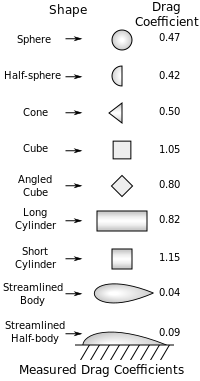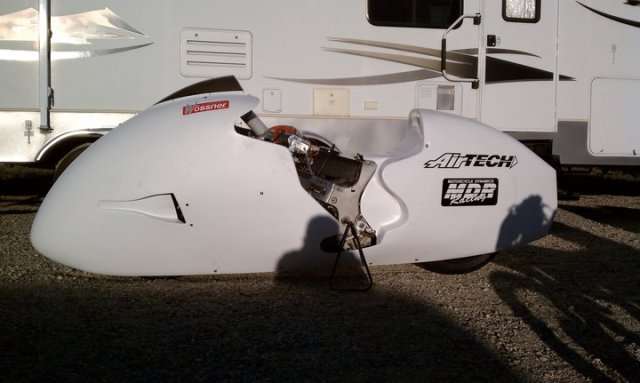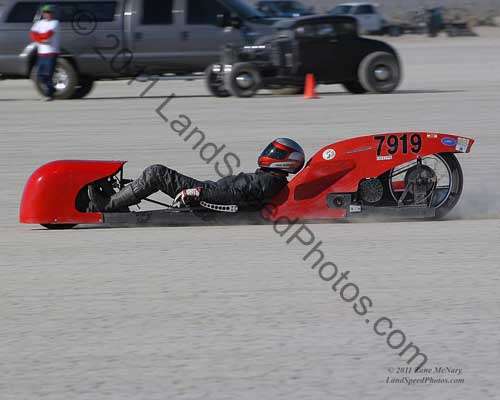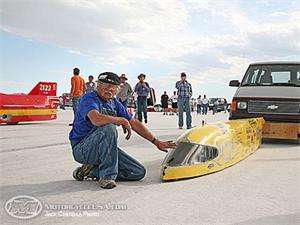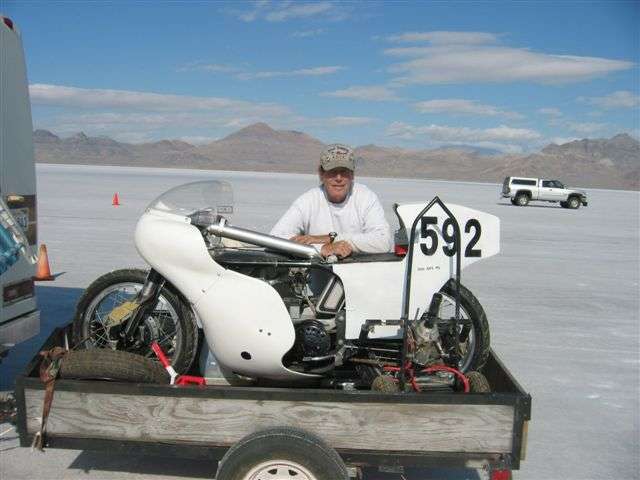Re: Ton with style - 250
Like others have said... it'll be difficult but not impossible. Changes in gearing and rear tire size will probably be necessary, but that alone won't do it. Higher gearing (bigger front sprocket, smaller rear sprocket, and/or larger diameter rear wheel) also makes the engine work harder. At some point, the horsepower is going to come up against the drag caused by the air and you're not going to go any faster.
Top speed runs (at moderate speeds, less than 180 or so) have mostly to do with power, gearing, and the co-efficient of drag.
For drag, this means reducing the aspect of the bike. Looking straight on, you want your bike to look as small as possible. What areas are exposed, should be be tailored to look like the "streamlined body" in the following following pic:
Avoid the half-streamlines pic as this is actually an airplane wing and will cause strange things at high speed (depending on the location and orientation).

Use whatever you need to get rid of blocky edges and other "bad" shapes. Duct tape works quite well as a temporary solution. A properly built fairing will do you a world of good.
As for gearing, you sound like you have this well underway. Don't overgear it though. As I mentioned earlier, the longer the gears, the more power it takes to hit a certain RPM. Pick a setup that will let you hit your target speed at redline. Engine modifications may improve your redline, so take that into account.
For more power, you have a few options. First of all, you'll want to stack your mods accordingly. All modifications done to the engine should take (the most) effect in a fairly narrow portion of the power band. Lets say your redline is 10,000 RPM. You want to target the mods to kick in around 8,000 RPM or so.
Option 1: Camshaft
Let me premise this by saying that I don't know a cam manufacturer that offers alternatives to the stock GN250, but if you can find one, get the most radical grind you can.
Aftermarket cams work by changing the amount of time the intake and exhaust valves are open for every rotation of the crankshaft. This is called the duration and it is usually measured in degrees. Stock cams are built mainly with noise and environmental factors in mind. A radical cam (one with higher duration) will open the valves sooner and close them later. What this means in real-world terms is that as the speed of the engine increases, the inertia of the gases entering and leaving the engine increase as well. As their inertias increase, the gasses will start to compress themselves, improving volumetric efficiency. Think of it this way, if two people are walking very closely in single file and the first person stops (the air stopping against the piston after entering the cylinder) then they will get bumped a bit. If you repeat this same scenario but both people are running, then the first person gets bumped a lot more! The same thing is happening with the air coming into your engine. The fast-moving air from the intake will squish itself into the cylinder (at an increasing rate) but this only occurs of the valves stay open long enough. A similar situation occurs with the exhaust, only instead of pushing, the inertia of the exhaust gases will "pull" spent gases from the cylinder, allowing in additional fresh mixture.
Increased duration pushes the powerband way up on the RPM range and provides much more hp when you wind out the engine. Down side is that you're going to lose a lot of power at lower RPMs because the gases don't have enough inertia to overcome the pressures and you get what is known as reversion (exhaust gases coming from the pipe back into the cylinder and unspent fuel/air mixture going back into the intake). Make sure your bike still has the power at the low RPMs to take you into the high RPMs where the cam will be of use. Proper gearing should help to alleviate this problem. Duration aside, many cams will offer increased lift as well. Make sure your valve springs can cope and that there is no contact from the valves to the pistons.
Option 2: Compression
Increase compression will increase horsepower throughout the RPM band by increasing the thermal efficiencies. Too much compression leads to detonation. 12:1 is doable with a good squish area (custom pistons) and decent cooling. Make sure you run premium gas.
Option 3: Displacement
You may consider this a bit of a cheat, but you can increase the displacement of your bike by boring out the cylinders and/or stroking it. Almost all motorcycles (that I know of) will run higher bore than stroke. This is called oversquare. Engines with more stroke than bore are called undersquare. Generally speaking, oversquare engines provide more power at higher RPMs whereas undersquare engines provide more power at lower RPMs. Undersquare engines are usually a bit more efficient though, allowing increased compression. It's not likely you'll be able to drastically change this characteristic if your engine though, so consider it academic.
Option 4: Spark Advance
Advancing the ignition timing is a good way to get a few ponies at higher RPM. As the engine revs, the movement of the pistons begins to "beat" the speed at which the flame travels through the fuel/air mixture. This results in wasted power because the inertia of the moving piston begins to outpace the pressure of the exhaust gases. The solution is to light the mixture sooner so that more pressure is available to push the piston back downward and it isn't relying so much by being pulled down by rotation forces of the crankshaft or other pistons. Too much advance will blow up your engine because it drastically increases dynamic compression and heat. Run premium or race fuel to help.
Option 4: Intake
Velocity stacks are probably your best bet for high power. Stacks work by introducing a vortex into the incoming air. This smoothes out the airflow coming into the carburetor and allows, not only, for easier tuning but more total air flow into the engine. When all the air molecules are heading in the same direction and not bumping into one another, you can get more of them into the same space. More air = more fuel = more power. The length of the stacks will matter. Generally, shorter stacks are better for high RPM and longer stacks will aid lower RPMs. There's some math that will help you in this decision, let me know if/when you need the details. As for the port and polish, I advise you skip it. A little but of turbulence after the carb venturi helps to keep the fuel atomized and on most bikes, the intake ports are oversized already.
Option 5: Exhaust
Bigger is not always better. I don't know where the following number comes from, but I've been told and I've read that 300 feet per second is about ideal for exhaust gas speeds. Numerous bends and/or constrictions will affect this, so try to keep your exhaust straight, centered, and pointed toward the back of the bike. The reasons to tune the exhaust have, again, to do with the inertia of the air. Keeping the exhaust gases moving well helps to "pull" more exhaust gases from the engine. When calculating how big the pipes need to be, first determine the displacement of a single cylinder and multiply that by 4.25 (this is roughly the increase in volume the air/fuel mixture undergoes during combustion). This is how much exhaust is produced per cycle, per cylinder, per half RPM in a given minute. The formula for determining air flow speed is "v = 4q / A" where v is the air speed if the exhaust gas in meters per second and q is the volume of gas in cubic meters. Solving for 'A' will tell you the necessary cross section of the pipe in meters squared. After determining the ideal size of piping, ensure that the exhaust pipe is at least long enough to allow the exhaust gases to be contained within the exhaust during the time it takes for a second pulse to enter the pipe again. Remove your mufflers. Finally, if you're using 2 into 1 headers or something of the like, all this changes.
Option 6: RPMs
Increasing your redline will increase your horsepower. Today's sportbikes don't make considerably more torque than the bikes of 30 years ago, they just happen rev up to 18,000 RPM instead of 9,000. That directly translates into usable power. The "redline" is not always a hard and fast measurement where the engine suddenly blows up or stops working. Many bikes got a set a "redline" simply because they stopped producing power past that level. There are a number of things which affect this. First, I mentioned earlier that a mellow cam will result in low power at higher RPMs and that is often a contributing factor. The other major obstacle to high RPMs is the inertia of the engine itself. It takes power to go faster and the a traditional four-stroke engine works, it robs itself of that power that faster it goes. Pistons must switch directions over a hundred times per second and it takes a lot of energy to not only get them moving, but also to stop them. Valve springs need to be light because, they to, get compressed and decompressed many times per second. Make the springs too weak and the valves don't close when they need to. Too strong and they work against the engine opening them and add more to the weight. Piston rings dragging on cylinder walls as they travel lead to further losses. High viscosity oils cause losses as well. There's no one magic bullet for increasing RPMs, but losing as much weight as possible from the internals of the engine is an excellent starting point. Consider forged aluminum pistons with shorter skirts, titanium spring retainers, and shot peened chrome moly conn rods as starters.
Option 7: Forced Induction
Forced induction is likely to provide you with the most hp per $$$ spent. It's not uncommon to safely double the horsepower using more efficicient FI options such as turbos. Superchargers are generally easier to install, but not as efficient as a turbo. Nitrous Oxide can add a quick boost of power as well. All have their hazards and/or complications though. Reliable charging is much easier on an EFI engine, but as you're likely to only be concerned with WOT operations, tuning a carb to handle this shouldn't be too bad.
Those are just a few of the options available. There are probably countless other things I have missed, but I will also say that your engine is only as good as its weakest link. It operates as a single unit and to think you can make the whole thing run better by replacing only a part or two is perhaps a bit of a mistake. If you're serious about this endeavor, get ready to spend some cash; speed doesn't come cheap. I also advise getting the engine blueprinted. There is a lot of loss due to parts being "in spec" but not perfect.


